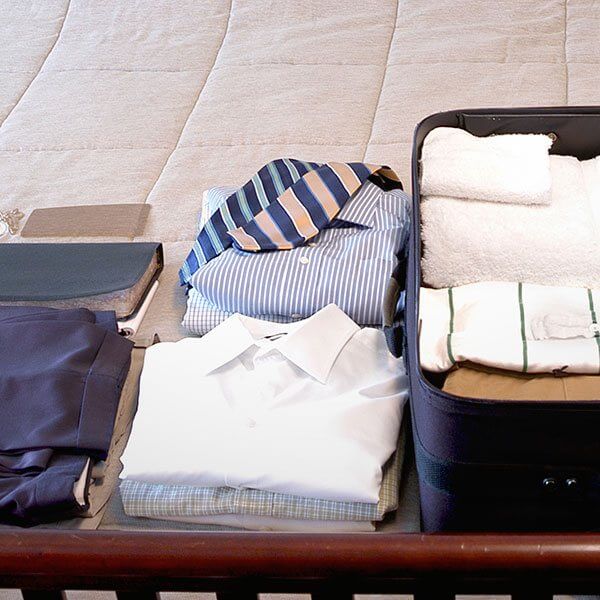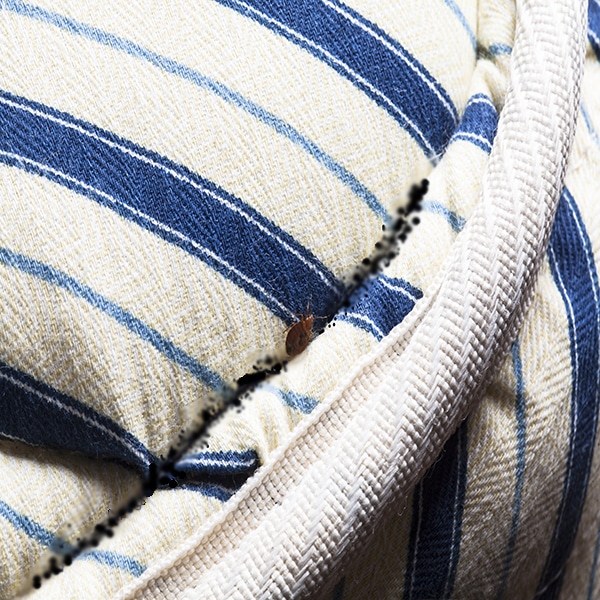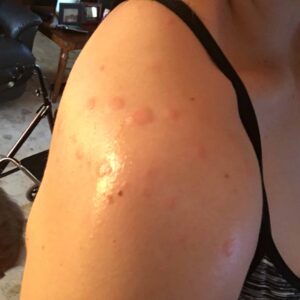
In the article
Bed Bug Behaviour
So, how did I get bed Bugs? Bed bugs are stealthy, nocturnal creatures that thrive on the blood of humans and animals while they sleep. These night prowlers come out to feed when you’re deep in slumber, but during the day, they’re masters of disguise, hiding in mattress seams, bed frames, headboards, and even behind wallpaper.
Attracted by the warmth of your body and the carbon dioxide you exhale, bed bugs use their needle-like beaks to pierce your skin and enjoy a blood meal lasting 3 to 10 minutes. Once sated, they scurry back to their hideouts to digest. These resilient pests can survive for months without feeding, making them a formidable adversary in your quest for a bed-bug-free home.
Behavioural Traits:
Activity: Nighttime prowlers
Feeding Duration: 3 – 10 minutes
Hiding Spots: Mattress seams, bed frames, headboards, behind wallpaper
Attraction: Body heat, carbon dioxide
Survival Without Feeding: Several months
Curious about their origins? Check out our detailed page on where bed bugs come from?.
Bed Bug Identification
Identifying bed bugs is crucial for effective treatment. These tiny, oval-shaped insects are reddish-brown and about the size of an apple seed (5-7 mm). After feeding, their flat bodies swell and elongate.
Bed bug eggs are minuscule, white, and pinhead-sized—almost impossible to spot without magnification. Nymphs, or baby bed bugs, are smaller and lighter in color, shedding their skin five times as they grow into adults.
Life Stage Identification:
– Adult: 5-7 mm, reddish-brown
– Nymph: Smaller, lighter in color
– Egg: Pinhead-sized, white
Watch for signs like small blood stains on your sheets, dark fecal spots, and shed skins. Bites on your skin, often in lines or clusters, are another telltale sign.
For information on their lifespan, see our article on how long bed bugs live?
Why Bed Bugs Invade Your Space
Understanding why bed bugs invade your home is key to preventing infestations. Let’s break down how these pesky critters sneak in and what makes your home appealing to them.
How Did I Get Bed Bugs Inside:
- Travel: Bed bugs hitch rides on luggage, clothes, and personal items. Hotels and hostels are their favorite jumping-off points.
- Second-Hand Furniture: Used mattresses, bed frames, or couches can be bed bug magnets.
- Public Transport: Buses, trains, and taxis can carry bed bugs on seats and fabrics.
- Neighboring Infestations: In apartments or condos, bed bugs can crawl through walls, floors, and ceilings.
- Visitors: Friends or family can unknowingly bring bed bugs into your home.

What Makes Your Home Inviting:
– Warmth: Bed bugs are drawn to warmth, much like your body heat.
– Carbon Dioxide: The CO2 you exhale is a signal for bed bugs.
– Clutter: Clutter provides ample hiding spots for bed bugs to thrive.
– Darkness: They prefer dark spots for hiding during the day.
– High Turnover: Places with frequent guest turnover, like hotels and dorms, are bed bug hotspots.
Factors That Attract Bed Bugs:
– Warmth: Feels like body heat
– Carbon Dioxide: Signals a human nearby
– Clutter: Provides perfect hiding spots
– Darkness: Ideal for hiding and feeding
– High Turnover Locations: More chances to spread
Signs of a Bed Bug Infestation
Early detection of bed bugs can save you from itchy nights and headaches. Here’s what to watch for, from physical evidence to bite marks.
Physical Evidence:
– Bed Bug Droppings: Tiny dark spots resembling ink stains.
– Shed Skins: Exoskeletons from growing bed bugs found near hiding spots.
– Blood Stains: Small blood spots on sheets or mattresses.
– Live Bed Bugs: Small, brown insects about the size of an apple seed.

Bed Bug Bites:
Bed bug bites are often the first sign of an infestation. These bites typically occur at night when bed bugs are most active.
Bite Characteristics:
– Appearance: Red, itchy welts, often in a line or cluster.
– Location: Exposed skin like the face, neck, arms, and hands.
– Reaction: Reactions vary from no reaction to severe itching.
Bite Signs:
– Appearance: Red, itchy welts in a line or cluster
– Location: Exposed skin: face, neck, arms, hands
– Reaction: Varies from no reaction to severe itching

Bed Bug Bites
How to Keep Bed Bugs Out of Your Life
Preventive Tips:
Keeping bed bugs out isn’t rocket science, but it requires diligence. Here’s how to stay ahead of these pesky invaders:
– Check Your Stuff: Regularly inspect mattresses, bed frames, and furniture.
– Cover Up: Use protective covers on mattresses and box springs.
– Vacuum Often: Regularly vacuum floors, carpets, and furniture.
– Declutter: Reduce hiding places by keeping sleeping areas tidy.
– Second-Hand Scrutiny: Inspect second-hand furniture, clothes, and luggage before bringing them home.
– Hot Wash: Wash and dry bed linens, curtains, and clothes on high heat.
– Seal It Up: Close cracks and crevices in walls, baseboards, and furniture.
– Travel Smart: Inspect hotel rooms for bed bugs and keep luggage off the bed.
Getting Rid of Bed Bugs Fast & Forever DIY:
If you think you have bed bugs, don’t panic. Just follow these easy 3 steps to get rid of bed bugs fast and forever.
Step 1: Secure the Mattress
Start by covering your sleeping mattress with a bed bug mattress cover, ensuring it’s zipped up and the tab is closed. This traps bed bugs inside, eventually killing them through starvation. It also helps spot bed bugs because the covers remove hiding spots on the mattress.
Step 2: Treat the Bed Frame or Ensemble Base
– Ensemble Beds:
Stand the base on its end, remove all the wheels and cover it with a bed bug mattress cover, and zip it up completely. Screw the wheels back into the base, piercing the cover with the bed leg screws.
– Bed Frames with Slats:
Use a Bed Bug Steamer to steam the entire bed frame, paying special attention to cracks and crevices. Remove the slats and steam on both the top and bottom surfaces of the slats.
Before replacing bed slats, apply Bed Bug Killer powder to the bed frame and slats using a Bed Bug Killer Duster. Ensure the powder covers every inch, including the undersides.
Step 3: Set Up Barriers or Tape
To protect yourself from bed bugs in the room, use Bed Bug Barriers:
- Screw-in Barriers: Attach these to the legs of ensemble beds. Apply powder inside and outside the barriers and on the wheels.
- Floor Barriers: Place bed legs in the Floor Barrier, dusting powder inside the tray and barrier.
- Bed Bug Barrier Tape: For square bed legs or those larger than 65mm, use the tape at the bottom of the legs, dusting powder around the leg and floor.
Final Tips:
– Keep your bed at least 30cm away from walls, bedside tables, and other furniture to prevent bed bugs from climbing on your bed.
– Isolate the bed so the only access points are the bed legs. This setup will kill bed bugs in the room within a few weeks to a month, regardless of their hiding places.
Following these steps will ensure bed bugs are effectively eliminated from your bed and room, allowing you to sleep peacefully, knowing you’re protected.
Frequesntly Asked Questions:
- How Did I Randomly Get Bed Bugs?
Bed bugs are notorious hitchhikers. You can randomly get bed bugs from a variety of sources even if you haven’t been anywhere recently. They can latch onto your clothes, luggage, or personal items from public places such as buses, trains, and taxis. If you’ve had visitors, they might have unknowingly brought these pests into your home. Additionally, bed bugs can spread through shared laundry facilities or from neighbouring infested apartments through cracks in walls, floors, or ceilings. - How Did I Get Bed Bugs When I Haven’t Been Anywhere?
Even if you haven’t travelled or stayed in infested places, bed bugs can still find their way into your home. They can hitch a ride on second-hand furniture, clothing, or mattresses. Guests or delivery personnel who have been in infested areas might also bring them into your space. Bed bugs are also known to move between connected housing units, such as apartments or condos, through electrical outlets, pipes, or other openings in walls. - Are Bed Bugs Caused by Poor Hygiene?
No, bed bugs are not caused by poor hygiene. These pests are attracted to warmth and carbon dioxide, which humans naturally emit, regardless of cleanliness. While clutter can provide more hiding spots for bed bugs, they can infest even the cleanest of homes. Bed bugs are equal-opportunity invaders and their presence is not an indicator of poor hygiene. It’s essential to stay vigilant and take preventive measures to keep them at bay.
Are You Looking for an Organic DIY Treatment?



Leave a Reply